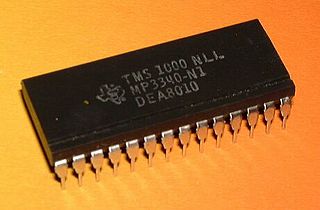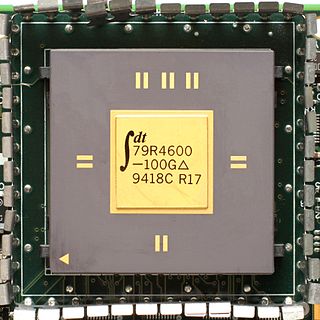This article includes a list of references, but its sources remain unclear because it has insufficient inline citations .(March 2019) (Learn how and when to remove this template message) |
| POWER, PowerPC, and Power ISA architectures |
|---|
| Freescale (formerly Motorola) |
| IBM |
| IBM–Nintendo |
| Other |
| Related links |
| Cancelled in gray, historic in italic |
The PowerPC e200 is a family of 32-bit Power ISA microprocessor cores developed by Freescale for primary use in automotive and industrial control systems. The cores are designed to form the CPU part in system-on-a-chip (SoC) designs with speed ranging up to 600 MHz, thus making them ideal for embedded applications.
In computer architecture, 32-bit integers, memory addresses, or other data units are those that are 32 bits wide. Also, 32-bit CPU and ALU architectures are those that are based on registers, address buses, or data buses of that size. 32-bit microcomputers are computers in which 32-bit microprocessors are the norm.

The Power ISA is an instruction set architecture (ISA) developed by the OpenPOWER Foundation, led by IBM. It was originally developed by the now defunct Power.org industry group. Power ISA is an evolution of the PowerPC ISA, created by the mergers of the core PowerPC ISA and the optional Book E for embedded applications. The merger of these two components in 2006 was led by Power.org founders IBM and Freescale Semiconductor. The ISA is divided into several categories and every component is defined as a part of a category; each category resides within a certain Book. Processors implement a set of these categories. Different classes of processors are required to implement certain categories, for example a server class processor includes the categories Base, Server, Floating-Point, 64-Bit, etc. All processors implement the Base category.

A microprocessor is a computer processor that incorporates the functions of a central processing unit on a single integrated circuit (IC), or at most a few integrated circuits. The microprocessor is a multipurpose, clock driven, register based, digital integrated circuit that accepts binary data as input, processes it according to instructions stored in its memory and provides results as output. Microprocessors contain both combinational logic and sequential digital logic. Microprocessors operate on numbers and symbols represented in the binary number system.
Contents
The e200 core is developed from the MPC5xx family processors, which in turn is derived from the MPC8xx core in the PowerQUICC SoC processors. e200 adheres to the Power ISA v.2.03 as well as the previous Book E specification. All e200 core based microprocessors are named in the MPC55xx and MPC56xx/JPC56x scheme, not to be confused with the MPC52xx processors which is based on the PowerPC e300 core.

The MPC5xx family of processors such as the MPC555 and MPC565 are 32-bit PowerPC embedded microprocessors that operate between 40 and 66 MHz and are frequently used in automotive applications including engine and transmission controllers. Delphi Corporation use either the MPC561 or MPC565 in the engine controllers they supply to General Motors, with nearly all 2009 model GM North America vehicles now using an MPC5xx in the engine controller. Bosch also used the MPC5xx throughout the EDC-16 series of Diesel Engine Controllers as did the Cummins B series diesel engine ECU.
PowerQUICC is the name for several PowerPC- and Power ISA-based microcontrollers from Freescale Semiconductor. They are built around one or more PowerPC cores and the Communications Processor Module which is a separate RISC core specialized in such tasks such as I/O, communications, ATM, security acceleration, networking and USB. Many components are System-on-a-chip designs tailor made for embedded applications.

The PowerPC e300 is a family of 32-bit PowerPC microprocessor cores developed by Freescale for primary use in system-on-a-chip (SoC) designs with speed ranging up to 800 MHz, thus making them ideal for embedded applications.
In April 2007 Freescale and IPextreme opened up the e200 cores for licensing to other manufacturers. [1]
Continental AG and Freescale are developing SPACE, a tri-core e200 based processor designed for electronic brake systems in cars. [2]
Continental AG, commonly known as Continental, is a German automotive manufacturing company specializing in, brake systems, interior electronics, automotive safety, powertrain and chassis components, tachographs, tires and other parts for the automotive and transportation industries. Continental is based in Hanover, Lower Saxony, Germany. Continental is the world's fourth-largest tire manufacturer.
STMicroelectronics and Freescale have jointly developed microcontrollers for automotive applications based on e200 in the MPC56xx/SPC56x family.

STMicroelectronics is a French-Italian multinational electronics and semiconductor manufacturer headquartered in Geneva, Switzerland. It is commonly called ST, and it is Europe's largest semiconductor chip maker based on revenue. While STMicroelectronics corporate headquarters and the headquarters for EMEA region are based in Geneva, the holding company, STMicroelectronics N.V. is registered in Amsterdam, Netherlands.






